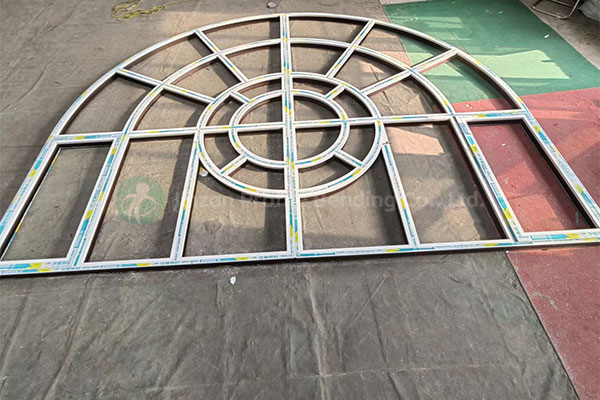Redefining the construction industry with innovative solutions, cuttin-edge technology and sustainable practices
Profile Bending 2025-08-15
he industrial stretch forming process is widely used for shaping materials, particularly metals and plastics, into complex geometries. This technique is essential in various industries, including aerospace, automotive, and construction, where precision and efficiency are paramount. However, despite its advantages, the stretch forming process can encounter several common problems that may affect the quality and effectiveness of the final product. This article explores these challenges and offers practical solutions to enhance the stretch forming process.
1. Material Wrinkling
Problem:
One of the most common issues in stretch forming is material wrinkling. This occurs when the material is not evenly stretched, leading to folds or creases that can compromise the structural integrity and aesthetic quality of the part.
Solution:
To mitigate material wrinkling, it is crucial to ensure uniform tension across the material during the forming process. This can be achieved by:
- Adjusting the Tooling: Optimizing the design of the forming dies and tools can help distribute forces more evenly.
- Controlling Temperature: Preheating the material can increase its ductility, allowing for smoother stretching and reducing the likelihood of wrinkling.
- Using Wrinkle Control Devices: Implementing devices like anti-wrinkle flanges or guides can help maintain the desired shape and prevent material from folding.
2. Inconsistent Thickness Distribution
Problem:
Inconsistent thickness can lead to weak points in the formed part, making it susceptible to failure during use. Variations in material thickness may also result from uneven stretching or improper material handling.
Solution:
To address thickness distribution issues, manufacturers can:
- Conduct Material Testing: Before the forming process, testing the material for uniformity can help identify any weaknesses in thickness.
- Implement Finite Element Analysis (FEA): Using FEA software during the design phase allows engineers to predict how the material will behave and adjust the process accordingly.
- Monitor Stretching Parameters: Regularly checking parameters such as pressure and temperature during the stretch forming process can help maintain consistent material thickness.
3. Surface Defects
Problem:
Surface defects such as scratches, dents, or oxidation can occur during the forming process, affecting the aesthetics and functionality of the final product.
Solution:
To minimize surface defects, manufacturers should:
- Enhance Tooling Surface Quality: Ensuring that forming tools are well-maintained and polished can reduce the risk of surface damage to the material.
- Implement Protective Coatings: Applying protective coatings to the material before forming can help shield it from scratches and oxidation.
- Improve Handling Procedures: Training personnel in proper material handling techniques can prevent physical damage during transport and setup.

4. Tool Wear and Tear
Problem:
Frequent use of forming tools can lead to wear and tear, affecting their performance and the quality of the finished product.
Solution:
To prolong the lifespan of forming tools, manufacturers can:
- Regularly Inspect Tools: Implementing a routine inspection schedule helps identify wear early, allowing for timely maintenance or replacement.
- Use High-Quality Materials for Tools: Investing in durable materials for tooling can reduce wear and improve performance over time.
- Optimize Tooling Design: Designing tools with replaceable parts can help minimize downtime and maintenance costs.
5. Inadequate Material Flow
Problem:
Inadequate material flow during the stretch forming process can lead to incomplete shaping or uneven results. This issue is typically caused by insufficient lubrication or misalignment of the material.
Solution:
To ensure proper material flow, manufacturers should:
- Ensure Proper Lubrication: Applying the right type and amount of lubricant can reduce friction and facilitate smoother material movement.
- Align the Material Properly: Careful alignment of the material before starting the forming process is essential to achieve the desired shape and prevent flow issues.
- Adjust Process Parameters: Experimenting with different stretching speeds and pressures can help identify the optimal conditions for material flow.
6. Dimensional Inaccuracies
Problem:
Dimensional inaccuracies can arise from various factors, including thermal expansion, improper tooling, or variations in material properties. These inaccuracies can lead to parts that do not meet specifications.
Solution:
To minimize dimensional inaccuracies, manufacturers can:
- Implement Precise Measurement Techniques: Using advanced measurement tools such as laser scanners can help ensure that dimensions are within specified tolerances.
- Conduct Regular Calibration: Regularly calibrating equipment and tools can help maintain accuracy throughout the production process.
- Utilize Feedback Systems: Implementing feedback systems that monitor and adjust parameters in real-time can help maintain precise dimensional control.
The industrial stretch forming process is a valuable technique for producing complex parts in various industries. However, it is not without its challenges. By understanding common problems such as material wrinkling, inconsistent thickness, surface defects, tool wear, inadequate material flow, and dimensional inaccuracies, manufacturers can implement effective solutions to